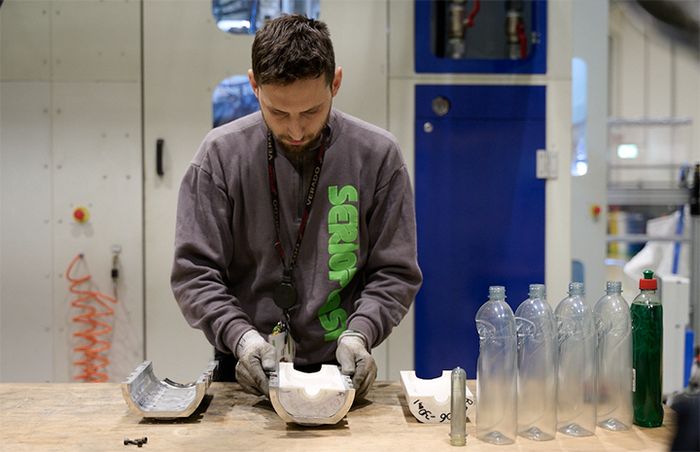3D Printing Slashes Unilever Bottle Design Costs
The CPG giant finds itself at the intersection of blowmolding and 3D printing and is relishing the returns.

At a Glance
- New approach to bottle prototyping slashes time and costs
- Benefits include up to 90% reduction in tooling expenses
- Sample bottles are essentially identical to production bottles
Unilever and plastic-packaging manufacturer Serioplast Global Services are transforming stretch blowmolded bottle prototyping using 3D printing technology from Formlabs. The result is much faster, less expensive mold making and prototype production and testing.
Working together in Italy, Unilever and Serioplast used 3D printing to rapidly create molds and produce pre-production sample bottles made of PET. The molds were built using Formlabs’ Rigid 10K Resin and Form 3L large-format, stereolithography (SLA) 3D printer.
The SLA 3D printing process enabled Serioplast to build resin molds in two days, a significant time savings vs. traditional machined metal molds (typically outsourced to a vendor), which take four to eight weeks to produce.
The printed molds also reduced lead time for pilot testing of blow-molded PET bottles. Lead time to produce 200 bottle samples using the printed molds was only two weeks, vs. the six to eight weeks required with conventional molds.
Printing the molds reduced tooling cost by up to 90% vs. metal molds. Specifically, the printed molds cost $500 to $1,000 to make vs. $2,500 to $10,000 for machined metal molds.

Stefano Asnaghi, R&D lead technologist of Serioplast, checks the form and fit of the mold. UNILEVER
Resin handles the pressure.
To create the plastic molds, the team needed a resin that could endure the temperature and internal pressure of stretch blow molding and deliver dimensional accuracy and stability in the finished tooling. Formlabs’ Rigid 10K Resin provided the required strength, stiffness, and thermal resistance.
Formlabs describes the resin as an industrial-grade, highly glass-filled material with a tensile modulus of 10,000 MPa. Molds printed from the resin exhibit good dimensional stability and tolerate hundreds of blow-molding cycles, with repeatability.
To produce bottles with the printed molds, Serioplast used the same blow-molding process window as for a metal pilot mold.
“We are talking about up to 30-bar pressure. It’s absolutely good and reliable on that. We are also talking about 100 °C heating for the [bottle] preform without any wearing on the cavity of the 3D printer mold,” says Flavio Migliarelli, R&D design manager at Serioplast, in a Formlabs video interview.
The sample bottles made using the printed molds were nearly identical to production-quality bottles.
“The Formlabs machine plus the [Rigid] 10K Resin together offer the real possibility to have very good details on the bottles, [including logos or something] like a lemon detail, which requires a lot of precision,” says Stefano Cademartiri, CAD and prototyping owner at Unilever.
Produced using the same resin and on the same blow-molding equipment as production bottles, the samples were ideal for pilot testing.
Bottles pass line and consumer testing protocols.
So far, Unilever and Serioplast have tested about 15 bottle designs produced with the molds. Serioplast first created a standard mold design and print preparation and then modified the mold cavity for each unique bottle design.
The ability to rapidly iterate bottle designs and molds speed pilot evaluations by enabling testing of multiple designs at the same time.
The pilot included not only consumer testing but also primary validation of the bottle designs on Unilever’s filling line. This included bottle movement and how the containers functioned during filling, capping, and robotic case packing.
Additionally, Serioplast uses the printed molds to validate the stretch blow-molding process for the bottle designs. The company also performed dimensional analysis on the bottles and conducted performance evaluations, including bulge, cupping, and drop testing.
Through the art and science of 3D printing, “Something is on your screen, [and] in a short time is in your hands,” Cademartiri explains. “A real product with a real bottle, with a real cap, and the real label.”
About the Author(s)
You May Also Like




